Recovery of The Intuitive Self depended on successful reconciliation of the opposites encountered in exploring the shadow and anima. As long as unconscious subpersonalities sabotaged my behavior, I would be plagued with physical tension, fears and desires as well as mental clutter. Although integration would never be complete given the vast domain of the unconscious, sufficient progress had to be made to clear space for spontaneous expression of The Intuitive Self.
Mystery of Mysteries
The great mystery of primal opposites had intrigued the human race for millennia. In her version of the Tao Te Ching, Ursula LeGuin expressed the last lines of the first chapter:
Two things, one origin,
but different in name,
whose identity is mystery.
Mystery of all mysteries!
The door to the hidden. (Note 106)
The primal distinction I experienced tumbling in the yard with my grammar school friend Marlene haunted me. Who was this creature whose touch and fragrance were so different from mine? How could I reclaim some of that for myself? That was the mystery of mysteries.
How could I regress to the time when I was one with all? Before birth even before conception there must have been a state when I was not separate. Female companionship offered a way to reclaim a wholeness that transcended differences. Our similarities beneath the surface distinctions represented something more primal, something more subtle. These intimations from physical experience required intellectual exploration to satisfy the rational mind.
An early intellectual encounter with the paradox of opposites came through Robert Pirsig's Zen and the Art of Motorcycle Maintenance. He spoke of two kinds of understanding: classic and romantic. He told the story of a man, Phaedrus, gone mad from a split between the classic and romantic ways of thinking. The story was more about an internal split than one outside the self. To my surprise, classic form and romantic appearance were present in my computer programmer world.
My colleagues had little regard for flow charts and even less for decision tables. However, I was fascinated by both. On the surface, the drawings were lines and boxes with words in them. But to my classic self, they represented an underlying form spelling out the computer logic required to perform a task. On the other hand to my romantic self, there was a beauty in the finished diagrams. I held completed flow charts and decision tables at arm's length to appreciate their "wholeness." When I did them well, that is elegantly, they were "graceful."
Left Brain, Right Brain
In the early 1970s, differences in how the left and right hemispheres processed information found their way into the popular press. Robert Ornstein offered workshops on the educational implications of the research. Since the logical (left) versus non-logical (right) way of seeing things had become important personally, I attended Ornstein's program as a faculty development activity. He made frequent use of Sufi teaching stories translated by Idries Shah. This was my first encounter with the crazy wise man Mulla Nasrudin.
Chapter 2 in Ornstein's The Psychology of Consciousness summarized basic neurological research on the two sides of the brain. Studies by neuropsychologist Ralph Sperry of Joseph Bogen's split brain patients were featured. The strong evidence for different processing strategies found in patients who had the nerve fibers connecting the two hemispheres cut convinced my rational mind. 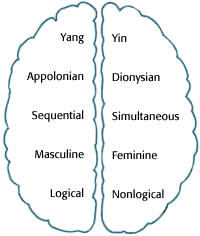 His discussion of two modes of consciousness left the most lasting impression.
His discussion of two modes of consciousness left the most lasting impression.
That chapter included term pairs for complementary duality from several cultural perspectives. From this list and others, I fashioned a drawing of the two hemispheres that included matching term pairs. The diagram was a staple in my information systems courses and later in my managerial decision making classes. Although opposite terms, they were clearly complementary. Resolving this paradox became my mission.
Balancing the Modes
I encountered this paradoxical challenge in general reading as well as science writers. Kahlil Gibran's Prophet was a favorite for years. As the left - right dichotomy took root in my consciousness, I rediscovered Gibran's passage on "Reason and Passion." My favorite lines suggested reconciliation in poetic metaphor:
Your reason and your passion are the rudder and the sails of your seafaring soul.
If either your sails or your rudder be broken, you can but toss and drift, or else be held at a standstill in mid-seas.
Here was a telling statement of the consequences of lopsided behavior. Reason (the rational style) and passion (the intuitive style) were the twin companions of success. Neglecting reason, I would lack direction and "toss and drift." Neglecting passion, I would lack momentum and be "held at a standstill." Recovery of a whole self clearly required both.
The Myers Briggs Type Indicator (MBTI) implementation of Jung's personality types classified me as an INTP. The Sensing Thinking (ST) and Intuitive Feeling (NF) types correlated with the left brain rational and right brain intuitive respectively. Intuitive Thinking (NT) placed me on the right brain end of the spectrum with Thinking offering left brain support. On an earlier administration of the MBTI, my type was INTJ. I had gradually shifted from strong to moderate Intuitive and from the Judging to the Perceptive emphasis.
While the MBTI descriptions were sufficient for general use, the original provided more depth. Reading Jung's description of the Introverted Intuitive Type suggested functions to encourage for an integrated personality. My primary relationships who were extraverts brought out that side in me. My spiritual quest nudged me from a Judging to Perceiving type since the latter was more consistent with soul searching. Even though I was now a Perceptive type, I used intuitive visions in my career since I had an appreciation for the Judging function.
Seagulls and Pelicans
When Richard Bach's pop publishing phenomenon Jonathan Livingston Seagull was all the rage, I was captivated by Jonathan's drive to excel. But on reflection, I sensed a fatal flaw in the public reverence for his style. I saw my drive to achieve regardless of the cost mirrored in his behavior. This passage captured the flavor of Jonathan's drive:
When they hear of it, he thought, of the Breakthrough, they'll be wild with joy. How much more there is to living! Instead of our drab slogging forth and back to the fishing boats, there's a reason to life! We can lift ourselves out of ignorance, we can find ourselves as creatures of excellence and intelligence and skill. We can be free! We can learn to fly! (Note 111)
On the surface, this sounded like Joseph Campbell's "follow your bliss." But hidden between the lines was an obsession to achieve at all costs. Others sensed something askew with Jonathan's drive. One was the former Catholic priest James Kavanaugh. In Celebrate the Sun, he introduced Harry Langendorf Pelican as an alternative to the Jonathan rage sweeping the country. His pelican suggested an alternative attitude:
"You live with illusions, Harry Langendorf," they said.
"Perhaps," he said, "But at present, for me, time is the illusion - and striving. Titles are an illusion - and progress." . . .
"But if everyone did as they pleased, Harry Langendorf, we would destroy ourselves," they said.
"I think we destroy ourselves when we do not do what pleases us," he said. . . .
"You are weird and strange, Harry Langendorf. Perhaps you are very sick."
"I feel very good," said Harry Langendorf. "But I have talked too much. After a point, words seem futile." (Note 112)
After reading both books several times, Harry's attitude seemed closer to the mark. But Kavanaugh and I were definitely in the minority. Harry's story sold a mere fraction of Jonathan's.
I described the seagull and pelican to students as metaphors for Wall Street (Jonathan) and Mallory Dock (Harry) attitudes. Wall Street was a "take charge doing" drive for success at any price. Each evening at sunset, Key West tourists gathered at Mallory Dock to experience the sunset moment. Street performers struted their stuff in a carnival atmosphere. Mallory Dock was a "laid back being" search for sunset serenity. I lived like Jonathan while Harry languished in my shadow.
Aldous Huxley outlined the broad strokes of a holistic education that avoided the problems of either Jonathan or Harry's extreme. With an emphasis on receptivity and analysis in all subjects, students were encouraged to develop their scientific and artistic capacities. These insights suggested I did not want to give up Jonathan's attitude to acquire Harry's outlook. The key was to find balance - a way of integrating the full rational intuitive spectrum in my life.
Achieving Integration
How could I transcend this paradox? How could I achieve the union of opposites? How could I avoid Jonathan's excess of doing or Harry's indulgence in being? Perhaps as the Tao Te Ching said, "The way to do is to be." A variety of images guided me through these perplexing waters. Each in its own way spoke to the need for reconciliation of the chakras as well as integration of the rational and intuitive as did these lyrics for "The Sphere" on the Hemispheres album by Rush:
We can walk our road together
If our goals are all the same
We can run alone and free
If we pursue a different aim.
Let the truth of Love be lighted
Let the love of Truth shine clear
Sensibility
Armed with sense and liberty.
With the Heart and Mind united
In a single perfect Sphere. (Note 115)
I used the lyrics at the beginning and end of a training video titled Opening Doors to Creative Expression. (Note 116) In the workshop summarized on the video, we used techniques covering the rational intuitive spectrum to encourage balance and flexibility in personal style. Other evocative images were a logo I discovered in Finland, Shiva and Sahkti as lovers, Kuan Yin sitting in repose and the Taoist circle yantra.
The Androgyne
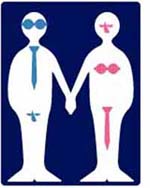 I spent a sabbatical semester in Finland. Soon after arriving, my attention was riveted by a poster logo in every shop window. Although I could not read a word, the logo image would not let go. I had to have a copy. My host talked a shopkeeper out of his display. The poster announced a women's consciousness raising workshop. Each person in the logo pair was their own androgynous Shiva Shakti. Jung would not have been surprised at this expression of the universal archetypes of anima and animus.
I spent a sabbatical semester in Finland. Soon after arriving, my attention was riveted by a poster logo in every shop window. Although I could not read a word, the logo image would not let go. I had to have a copy. My host talked a shopkeeper out of his display. The poster announced a women's consciousness raising workshop. Each person in the logo pair was their own androgynous Shiva Shakti. Jung would not have been surprised at this expression of the universal archetypes of anima and animus.
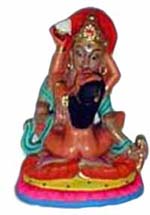 The union of Shiva and Shakti was a powerful metaphor in the resolution of the paradox. In the Hindu tradition, their union was symbolized by the hermaphrodite aspect of Shiva, Ardhanarisvara. Seen here in one of my favorite statues, Shiva and Shakti were, at one and the same time, a physical consummation of the divine union and an intimation of the union within. Their intercourse embraced all conflicting energies implied by the masculine feminine dichotomy whether as rational versus intuitive or lower chakras versus upper chakras.
The union of Shiva and Shakti was a powerful metaphor in the resolution of the paradox. In the Hindu tradition, their union was symbolized by the hermaphrodite aspect of Shiva, Ardhanarisvara. Seen here in one of my favorite statues, Shiva and Shakti were, at one and the same time, a physical consummation of the divine union and an intimation of the union within. Their intercourse embraced all conflicting energies implied by the masculine feminine dichotomy whether as rational versus intuitive or lower chakras versus upper chakras.
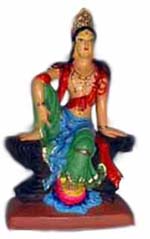 My fascination with the Chinese goddess Kuan Yin offered clues to a way out of the enigma. She evoked the quality of poise and equanimity. For several hundred years, the Kuan Yin icons had a distinctly androgynous visage. This statue which occupied a prominent location in my living room conveyed that sense. My prayers included petitions that she grant me her poise as a way of being in the world - a way that expressed feminine as well as masculine character. This was my inarticulate cry for help resolving the opposites.
My fascination with the Chinese goddess Kuan Yin offered clues to a way out of the enigma. She evoked the quality of poise and equanimity. For several hundred years, the Kuan Yin icons had a distinctly androgynous visage. This statue which occupied a prominent location in my living room conveyed that sense. My prayers included petitions that she grant me her poise as a way of being in the world - a way that expressed feminine as well as masculine character. This was my inarticulate cry for help resolving the opposites.
Move with the Present
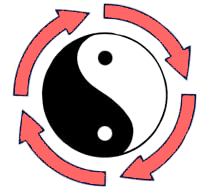 In Taoism, wei wu wei meant "doing - not doing." On first encountering this paradoxical statement, my mind did a double take. How could I be doing and not doing something at the same time. Perhaps this was not about experiencing both simultaneously. I realized that another way out of the conundrum was to transcend the dualism with an attitude that was neither but something more than either or both.
In Taoism, wei wu wei meant "doing - not doing." On first encountering this paradoxical statement, my mind did a double take. How could I be doing and not doing something at the same time. Perhaps this was not about experiencing both simultaneously. I realized that another way out of the conundrum was to transcend the dualism with an attitude that was neither but something more than either or both.
A hint of this appeared in the "Move With the Present" episode in the Tao of Managing where George used Michael's interest in sailing to explain doing nothing:
Well, consider the prospect of converting all of your daily tasks into joys instead of chores. Simply through a change of attitude. You see, you have this wonderful notion that who you are is defined by what you do. But if you can be really whole, and accept who you are,
He then quotes a line from Chapter 22 of the Tao Te Ching:
All things will come to you.
George continued the sailing metaphor to convey the subtle flavor of the doing - not doing attitude. Since Michael was autobiographical, that episode reflected my frustration trying to reconcile the opposites.
Tai Chi Dancer
What metaphor would emerge to represent resolution of the opposites? In answer, the Tai Chi Dancer image came. This four legged visage stood with one foot planted in the rational and intuitive as well as the lower and upper charkas. My Tai Chi Dancer floated like a willow in the wind responding to changing circumstances. I had to imagine flowing movement in which the shifting weight of the feet gave appropriate measure to each half of the two dimensions of the cross.
The four arms of the cross formed a quaternary. Carl Jung described the quaternity archetype which formed the basis for any whole judgment. The ideal of completeness was the circle whose natural minimal division was four. For many years, my personality rested on the two rational mode and lower chakras arms. The relative absence of the intuitive mode and upper chakras resulted in a lopsided orientation. I stumbled along with only two of the four cross arms at my disposal.
With the thinking function dominant, its feeling complement was buried in the unconscious. This resulted in periodic moods where fear and desire feelings of denied subpersonalities expressed themselves. These unexpected spells had a life of their own since they were beyond conscious control. I had to restore the intuitive mode and the upper chakras as conscious dimensions of self expression. I had to become an equal opportunity employer for my inner selves. This integration was worked out in the circumstances that shaped my career.
| Table of Contents | Next Thread |